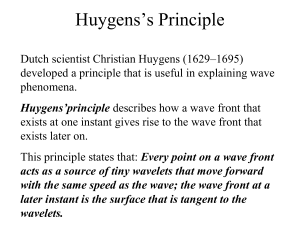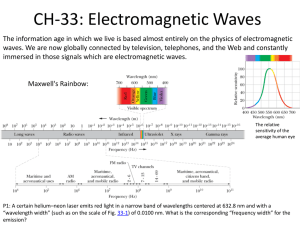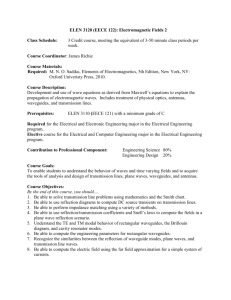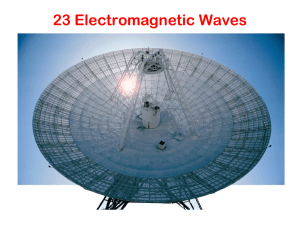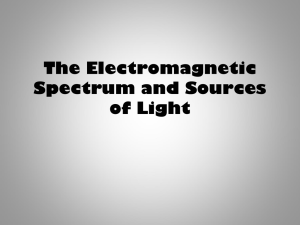Lecture slides
advertisement
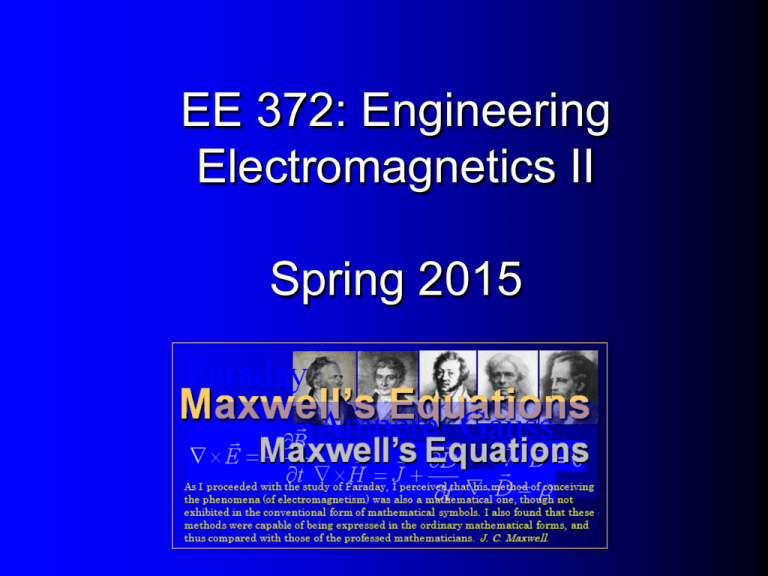
EE 372: Engineering Electromagnetics II Spring 2015 EM “Common Sense” Test 10 minutes Instructor Information Zhengqing (ZQ) Yun Hawaii Center for Advanced Communications (HCAC) Office: POST 201B Phone: 6-0759 Email: zyun@hawaii.edu http://www-ee.eng.hawaii.edu/~zqyun/courses/ee37215.html Times and Location Monday, Wednesday, and Friday 12:30 - 1:20pm Jan. 12 ~ May 6, 2105 (Instruction period) Holidays: 1/19 (Mon.), 2/16 (Mon.), 4/3 (Fri.); Spring break: 3/23 ~ 3/27; 44 hours total Location: POST 127 Prerequisites EE 371, PHYS 274, or instructor approval Office Hours 1:30 - 2:30pm, M, W, F By appointment Just walk in my office or email me Grading Homework: 30% Two midterms: 40% Final exam: 30% Extra points are possible Textbooks Electromagnetic Fields and Waves (required) Magdy F. Iskander, Waveland Press, ISBN: 1-57766-115-X Electromagnetic Waves (optional) D. H. Staelin, et al, Prentice Hall, 1994 ISBN: 0-13-225871-4 You are encouraged to read other EM books and papers. Contents Introduction (L01) Brief review of principles of wave motion (L02) Transverse Waves Longitudinal Waves Plane Waves, Cylindrical Waves, Spherical Waves Brief review of Maxwell's Equations (L03) Faraday's Law, Ampere's Law, Gauss' Laws Electromagnetic Waves The Electromagnetic Spectrum Wave equation and plane wave solution (L04~06): Harmonic wave equation in free space Plane wave solution Wave front and propagation direction Plane wave propagating in arbitrary direction Vector property of EM waves: polarization (L07~09) TEM waves Linear polarization Other polarizations Maxwell equations without del operator 𝛻 Contents Laws of reflection and refraction (L10~12): Fermat’s principle Derivation of law of reflection Derivation of law of refraction (Snell’s law) Other methods for deriving the laws Boundary conditions revisited Reflection and transmission coefficients (L13~14): Boundary conditions and polarization Reflection coefficient Transmission coefficient Total Reflection and Total Transmission (L15~16): Total reflection; critical angle Total transmission: Brewster (polarization) angle First midterm (L17~19) Contents Total field: incident + reflection on a PEC plane (L20~22): Perpendicular polarization Parallel polarization Standing/propagating waves Concept of phase velocity Boundary conditions and the uniqueness theorem Two-plate waveguide (L23~25): Field expressions/structures: result of multiple reflections Concept of modes Cut-off frequency Rectangular waveguide (WG) (L26~28): Boundary value problems Separation of variables solution method Possible modes in a rectangular waveguide Concept of WG wavelength Concept of WG impedance Other boundary value problems (L29~30): Rectangular resonators Circular waveguides Second midterm (L31~33) Contents Introduction to Antennas (L34~41): Radiation of a current element Far and near field Radiation pattern Directivity and gain Dipole Antennas Linear Antenna Arrays Ground effect (Image Method) Review for final (L42~44) Final: Monday, May 11, 12:00pm ~ 2:00pm Computer Animations & Simulations EM waves are not easy to be observed Computers are available on campus/at home Animations and simulations can explain subtle concepts and reveal physical insight Theory + Experiment + Simulation Course objectives Understanding fundamental concepts and laws governing the electromagnetic waves Understanding the mathematical formulation of these laws Learning basic problem-solving skills and research procedures Homework and exams Homework. You need to use all your learned knowledge and skills to solve the problems. All the steps should be clearly presented in the solutions. Calculators and/or computers are needed. Exams are testing your fundamental understanding of the subject. Numerical calculation is minimal. No calculators and computers are needed. Tips for Getting an A+ Attend all lectures Concentrate on EM stuff in classroom Learn problem solving skills from your peers; don’t copy their work Ask questions when you have any, not only in classroom, but also awat Participate classroom discussions You Can Get Extra Points! Solving challenge problems Doing extra homework Sharing news related to EM Finding mistakes in lectures and textbooks
